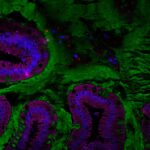Lien vers Pubmed [PMID] – 37443115
Lien DOI – 10.1186/s12989-023-00539-5
Part Fibre Toxicol 2023 Jul; 20(1): 27
Edible gold (Au) is commonly used as a food additive (E175 in EU) for confectionery and cake decorations, coatings and in beverages. Food-grade gold is most often composed of thin Au sheets or flakes exhibiting micro- and nanometric dimensions in their thickness. Concerns about the impact of mineral particles used as food additives on human health are increasing with respect to the particular physico-chemical properties of nanosized particles, which enable them to cross biological barriers and interact with various body cell compartments. In this study, male and female mice were exposed daily to E175 or an Au nanomaterial (Ref-Au) incorporated into food at relevant human dose for 90 days in order to determine the potential toxicity of edible gold.E175 or Ref-Au exposure in mice did not induce any histomorphological damage of the liver, spleen or intestine, nor any genotoxic effects in the colon and liver despite an apparent higher intestinal absorption level of Au particles in mice exposed to Ref-Au compared to the E175 food additive. No changes in the intestinal microbiota were reported after treatment with Ref-Au, regardless of sex. In contrast, after E175 exposure, an increase in the Firmicutes/Bacteroidetes ratio and in the abundance of Proteobacteria were observed in females, while a decrease in the production of short-chain fatty acids occurred in both sexes. Moreover, increased production of IL-6, TNFα and IL-1β was observed in the colon of female mice at the end of the 90-day exposure to E175, whereas, decreased IL-6, IL-1β, IL-17 and TGFβ levels were found in the male colon.These results revealed that a 90-day exposure to E175 added to the diet alters the gut microbiota and intestinal immune response in a sex-dependent manner in mice. Within the dose range of human exposure to E175, these alterations remained low in both sexes and mostly appeared to be nontoxic. However, at the higher dose, the observed gut dysbiosis and the intestinal low-grade inflammation in female mice could favour the occurrence of metabolic disorders supporting the establishment of toxic reference values for the safe use of gold as food additive.


